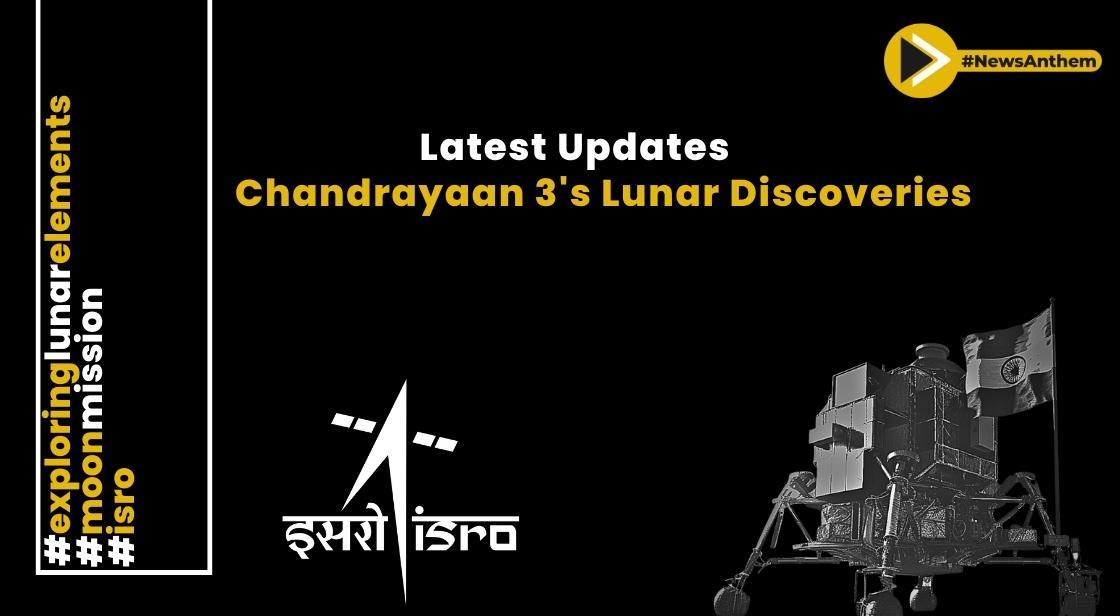Chandrayaan 3's Lunar Discoveries: Oxygen, Sulphur, Iron, and More

News Synopsis
In a remarkable stride towards unraveling the mysteries of the moon, Chandrayaan 3 has revealed crucial insights into the lunar surface. The mission, which successfully soft-landed on the moon's South Pole, has unveiled significant findings related to elements present on the moon and unique characteristics of the lunar landscape.
Confirmed Presence of Key Elements
Chandrayaan 3's scientific endeavors have yielded two major revelations. The mission has confirmed the existence of several essential elements on the lunar surface near the South Pole.
Notable elements include sulphur, aluminium, calcium, iron, chromium, titanium, manganese, oxygen, and silicon. These findings are crucial for understanding the composition and geological diversity of the moon's surface.
Exploring Lunar Elements
To depict the presence of these elements, Isro (Indian Space Research Organisation) released a comprehensive chart. This chart showcases the distribution of the identified elements based on their corresponding wavelength ranges.
Chandrayaan 3's observations provide valuable insights into the moon's chemical makeup, laying the foundation for further scientific investigations.
Unique Lunar Landing and Experiments
Chandrayaan 3's historic landing at the moon's South Pole marked a significant milestone in space exploration. The mission embarked on scientific experiments that were previously uncharted territory.
The lunar South Pole, chosen for its potential suitability for human colonization due to its reduced sunlight exposure, has now become the focus of groundbreaking research.
Potential Significance of Water
Chandrayaan 3's discoveries hold the key to unraveling the mystery of water presence on the moon. While the mission has already identified vital elements, the search for hydrogen is of particular interest. If Chandrayaan 3 successfully detects hydrogen, it would signify a significant step forward in deciphering the moon's water resources.
Navigating Lunar Craters and Terrain
As the Pragyan rover moved across the lunar surface to conduct experiments, it encountered a 4-meter diameter crater, situated just 3 meters ahead of its intended path. This encounter led to a strategic redirection of the rover's trajectory. The moon's South Pole is characterized by numerous craters, presenting both challenges and opportunities for exploration.
Temperature Insights:
Below and Above Ground Chandrayaan 3's investigations extended to measuring the moon's soil temperature at various depths. The results are intriguing, showcasing a range from minus 10 degrees Celsius to approximately 70 degrees Celsius.
Notably, temperatures were found to vary based on depth and proximity to the surface. Minus 10 degrees Celsius was recorded beneath the ground at a depth of 80 mm, while temperatures of around 60 degrees Celsius were observed approximately 20 mm above the surface.
Some additional facts about Chandrayaan 3's findings:
-
The presence of oxygen on the moon is significant because it could be a sign of water ice, which is essential for human survival.
-
The lunar temperature varies greatly depending on the location and time of day. The temperature can be as low as -10°C at night and as high as 70°C during the day.
-
The Pragyan rover is a robotic rover that is exploring the lunar surface. It has been able to move around despite the challenging terrain and has even encountered a crater.
Chandrayaan 3 is a major milestone in India's space program and has the potential to yield groundbreaking discoveries about the moon. The mission is expected to continue for several more months, and scientists are eager to see what else Chandrayaan 3 will find.
Conclusion
Chandrayaan 3's recent discoveries provide a tantalizing glimpse into the moon's intricate composition and environmental dynamics. With elements like oxygen, sulphur, iron, and silicon identified, along with insights into lunar temperatures and crater formations, the mission continues to reshape our understanding of Earth's celestial neighbor.
You May Like









